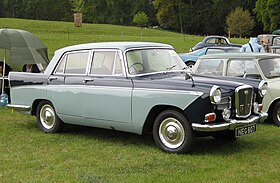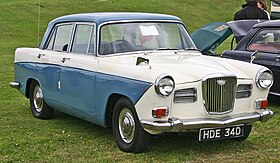
The Mini is a small, two-door, four-seat car produced by the British Motor Corporation (BMC) and its successors, from 1959 until 2000. Minus a brief hiatus, original Minis were built for four decades and sold during five, from the last year of the 1950s into the last year of the 20th century, over a single generation, as fastbacks, estates, and convertibles.
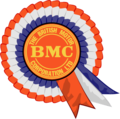
The British Motor Corporation Limited (BMC) was a UK-based vehicle manufacturer, formed in early 1952 to give effect to an agreed merger of the Morris and Austin businesses.

The Austin Motor Company Limited was an English manufacturer of motor vehicles, founded in 1905 by Herbert Austin in Longbridge. In 1952 it was merged with Morris Motors Limited in the new holding company British Motor Corporation (BMC) Limited, keeping its separate identity. The marque Austin was used until 1987 by BMC's successors British Leyland and Rover Group. The trademark is currently owned by the Chinese firm SAIC Motor, after being transferred from bankrupt subsidiary Nanjing Automotive which had acquired it with MG Rover Group in July 2005.

BMC ADO17 is the model code used by the British Motor Corporation (BMC) for a range of cars in the European 'D' market-segment of larger family cars, manufactured from September 1964 to 1975. The car was initially sold under the Austin marque as the Austin 1800, then by Morris as the Morris 1800, and by Wolseley as the Wolseley 18/85. Later, with a 2.2 L engine, also as the Austin 2200, Morris 2200 and Wolseley Six. Informally, because of the car's exceptional width and overall appearance, these cars became widely known under the nickname "landcrab"
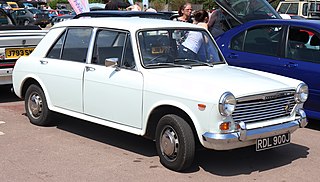
The BMC ADO16 is a range of small family cars built by the British Motor Corporation (BMC) and, later, British Leyland. Launched in 1962, it was Britain's best-selling car from 1963 to 1966 and from 1968 to 1971. The ADO16 was marketed under various make and model names; however, the Austin 1100 and Morris 1100 were the most prolific of all the ADO16 variants. The car's ubiquity at the height of its popularity led to it simply being known as the 1100 (eleven-hundred) in its home market. Also made with a 1275cc engine, it was then typically called 1300.

The BMC B series was a line of straight-4 & straight-6 internal combustion engine mostly used in motor cars, created by British automotive manufacturer Austin Motor Company.

The Riley Pathfinder is an automobile which was produced by Riley Motors Limited in the United Kingdom from 1953 to 1957. It was first presented at the London Motor Show in October 1953 and replaced the RMF as Riley's top-line model.
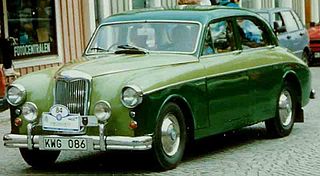
The Riley Two-Point-Six is an automobile produced by British Motor Corporation Limited (BMC) from August 1957 until 1959. It replaced the Pathfinder as Riley's flagship model when it was announced on 23 August 1957. While its predecessor retained the renowned Riley four-cylinder twin-cam cross-flow engine, coil rear suspension and gearbox, the Two-Point-Six was virtually identical to the Wolseley Six-Ninety Series III. It featured both monotone and duotone paintwork, as did the last of the Pathfinders. As per the Wolseley Six-Ninety Series III, right hand drive cars with a manual gearbox had a right hand gear lever; LHD cars a left hand gear lever. An automatic transmission and an overdrive for the manual gearbox were available as options.

The Riley One-Point-Five and similar Wolseley 1500 are cars produced by Riley and Wolseley respectively from 1957 until 1965. They utilised the Morris Minor floorpan, suspension and steering but were fitted with the larger 1,489 cc (90.9 cu in) B-Series engine and MG Magnette gearbox.

The Riley 4 / Sixty Eight and Riley 4 / Seventy Two are cars produced by BMC from 1959 to 1969, under the Riley marque. They are closely related to the Pinin Farina-designed MG Magnette Mark III and Wolseley 15/60 and the simpler Austin A55 Cambridge Mark II, Morris Oxford V pair, sharing the MG's rear styling and engine. This Riley was the most expensive car in that series.

The Austin A40 Farina is a small, economy car introduced by Austin in saloon (1958) and A40 Countryman (1959) estate versions. It has a two-box body configuration. It was badged, like many before it, as an A40, consistent with Austin's naming scheme at the time, based on the approximate engine output in horsepower; and to distinguish it from other A40 models, it was also given a suffix name – this one being the Farina, reflecting the all-new design by Italian Battista Farina's Pinin Farina Turin studio.

The Austin Cambridge is a medium-sized motor car range produced by the Austin Motor Company, in several generations, from September 1954 through to 1971 as cars and to 1973 as light commercials. It replaced the A40 Somerset and was entirely new, with modern unibody construction. The range had two basic body styles with the A40, A50, and early A55 using a traditional rounded shape and later A55 Mark IIs and A60s using Pininfarina styling.

The MG Magnette is a car that was produced by MG between 1953 and 1968. The Magnette was manufactured in two build series, the ZA and ZB of 1953 through to 1958 and the Mark III and Mark IV of 1959 through to 1968, both using a modified Wolseley body and an Austin engine.

Wolseley Motors Limited was a British motor vehicle manufacturer founded in early 1901 by the Vickers Armaments in conjunction with Herbert Austin. It initially made a full range, topped by large luxury cars, and dominated the market in the Edwardian era. The Vickers brothers died and, without their guidance, Wolseley expanded rapidly after the war, manufacturing 12,000 cars in 1921, and remained the biggest motor manufacturer in Britain.
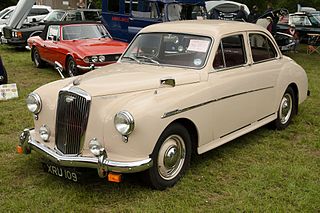
The Wolseley 15/50 was an updated version of the Wolseley 4/44. The main change was the engine; the 4/44 used a pre BMC Morris XPA unit and after the MG TF stopped production it was the only car still fitted with it. To rationalise production the 15/50 was launched with the BMC B-series engine fitted. Much of the design was shared with the MG Magnette, although some of the panels of the MG Magnette ZA/ZB are not interchangeable with those of the Wolseley 15/50, as stated in Practical Classics.

The Wolseley 6/90 is a car produced by Wolseley Motors Limited in the United Kingdom from 1954 to 1959. Announced on the first day of the October 1954 British Motor Show, the 6/90 replaced the 6/80 as the company's flagship model. It was badged with Six-Ninety on the bonnet and with 6/90 on the bootlid.

The Wolseley 24/80 is an automobile produced by British Motor Corporation (Australia) from May 1962 to October 1965, based on the British four-cylinder Wolseley 15/60 model.

The Wolseley 6/99 and 6/110 were the final large Wolseley cars. Styled by Pininfarina with additions by BMC staff stylists, the basic vehicle was also sold under two of BMC's other marques as the Austin A99 Westminster and Vanden Plas Princess 3-Litre. Production began in 1959 and the cars were updated and renamed for 1961. The Wolseley remained in production as the Wolseley 6/110 through to 1968.

The Austin Westminster series are large saloon and estate cars that were sold by the British manufacturer Austin from 1954, replacing the A70 Hereford. The Westminster line was produced as the A90, A95, A99, A105, and A110 until 1968 when the new Austin 3-Litre took its place. Essentially badge-engineered versions of the Farina Westminsters were also produced using the premium Wolseley and Vanden Plas marques. 101,634 Westminsters were built.

The Morris Oxford Farina is a series of motor car models that were produced by Morris of the United Kingdom from 1959 to 1971. The Farina name coming from the Italian design studio employed for styling.

